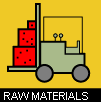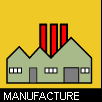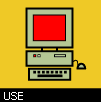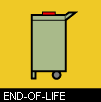|
|
 |
|
|
The product life cycle
|
|
The most effective way to reduce the impact on the environment is to integrate environmental considerations into the product development process. To do this, designers must consider the environmental impact of materials, energy and toxicity across an e–product’s entire life cycle.
|
The product life cycle begins when raw materials are extracted from the earth and ends when the materials from the products are reused, recycled, recovered or discarded. Currently, most of what we produce goes straight to landfill. The aim is to close the loop and recycle materials back into the manufacturing process. This will conserve the earth’s mineral resources, save energy (by reducing mining and transportation) and reduce waste.
|
|
|
 |
| FACTS & FIGURES |
 |
|
|
|
 |
More than 90% of the waste in the life cycle of a mobile phone is generated at the raw-material stage.
|
 |
A typical microwave will use more power illuminating its digital clock over its lifetime than it will actually cooking food.
|
 |
Manufacturing just one 32MB RAM module requires 32kg of water, 1.6kg of fossil fuels, 700g of gases and up to 72g of different chemicals.
Source: United Nations University, Tokyo
SEE MORE FACTS & FIGURES
|
|
 |
|
|
From start to finish
Ever wondered where your toaster came from? Every product goes through many different stages - from the raw materials to the finished item - and production processes.
|
|
 |
 |
|
Stage 1
Raw Materials
 |
mining metal ore and smelting into metal alloys |
 |
pumping oil and cracking into fuel to make plastics |
 |
refining sand into glass and semiconductors |
 |
cutting trees and processing them into wood or paper |
|
|
 |
 |
|
Stage 2
Manufacture – parts formation and assembly
 |
transforming material into part via mould or tool |
 |
combining parts into subassemblies |
 |
combining subassemblies into products |
 |
packing products for distribution |
|
|
 |
|
|
Stage 3
Purchase – from shelf to users
 |
exposure of product in retail outlet |
 |
support by advertising media |
 |
information about product (staff, advertising, leaflet) |
|
|
 |
 |
|
Stage 4
Use – consumption of product
 |
installation of products |
 |
first use |
 |
regular use |
 |
maintenance and repair |
|
|
 |
 |
|
Stage 5
Disposal – collecting and moving the used product
 |
consumer uses the collection system |
 |
collectors decide whether the product is reusable, recyclable, or disposable |
|
|
 |
|
|
Stage 6
Disposal – reuse, recycling and disposal,
and sorting and processing
 |
If reusable, the product is serviced, repackaged and redistributed |
 |
If recyclable, the product is disassembled: recyclable components are sent to recycling centres and non-recyclable components treated as disposable |
 |
If none of these apply, the product is landfilled or incinerated |
Assessing the environmental impact
Assessing designs in terms of their environmental impact can be complex. There may be cases where one option is better in terms of resource use, while another has a better emissions profile.
Many multinational companies use life cycle assessment (LCA) or abridged LCA software tools to evaluate the potential environmental impact of a product system. However, LCA works best retrospectively and is not much use in the early stages of product development, when ideas are not detailed enough to measure material use, energy consumption and impacts. LCA can also be time-consuming and costly.
Assessing products from a life cycle point of view can be difficult, given the wide range of possible impacts - both positive and negative. For example, if plastic is recycled, the process eliminates the negative impacts associated with oil extraction and refining, as well as the manufacture of virgin polymers. At the same time, the recycling process can have negative impacts, in this case relating particularly to the collection of a bulky material, and to polymer separation and processing.
(Holdway and Walker, 2004)
Next: Break even points
|
|
|





